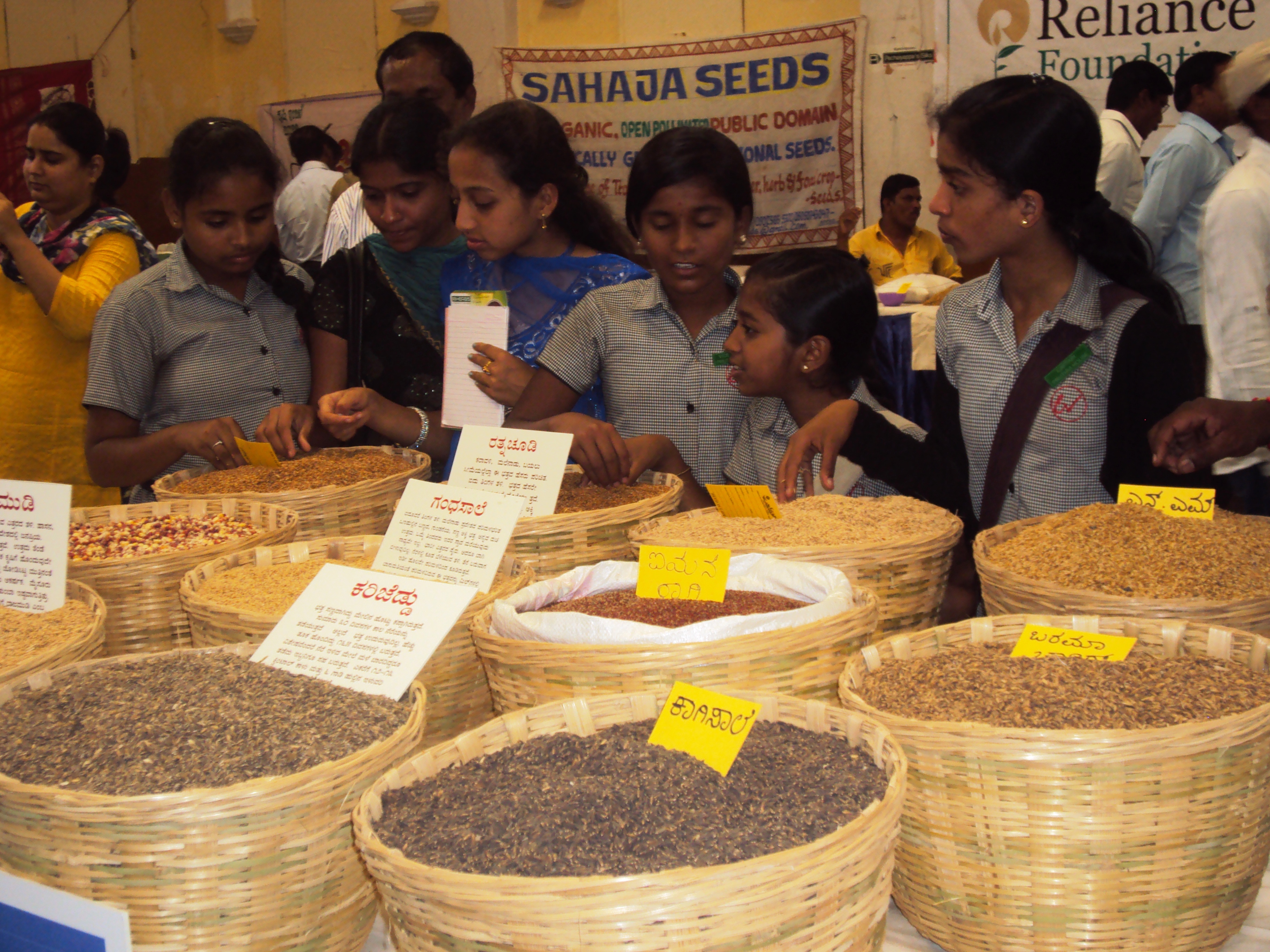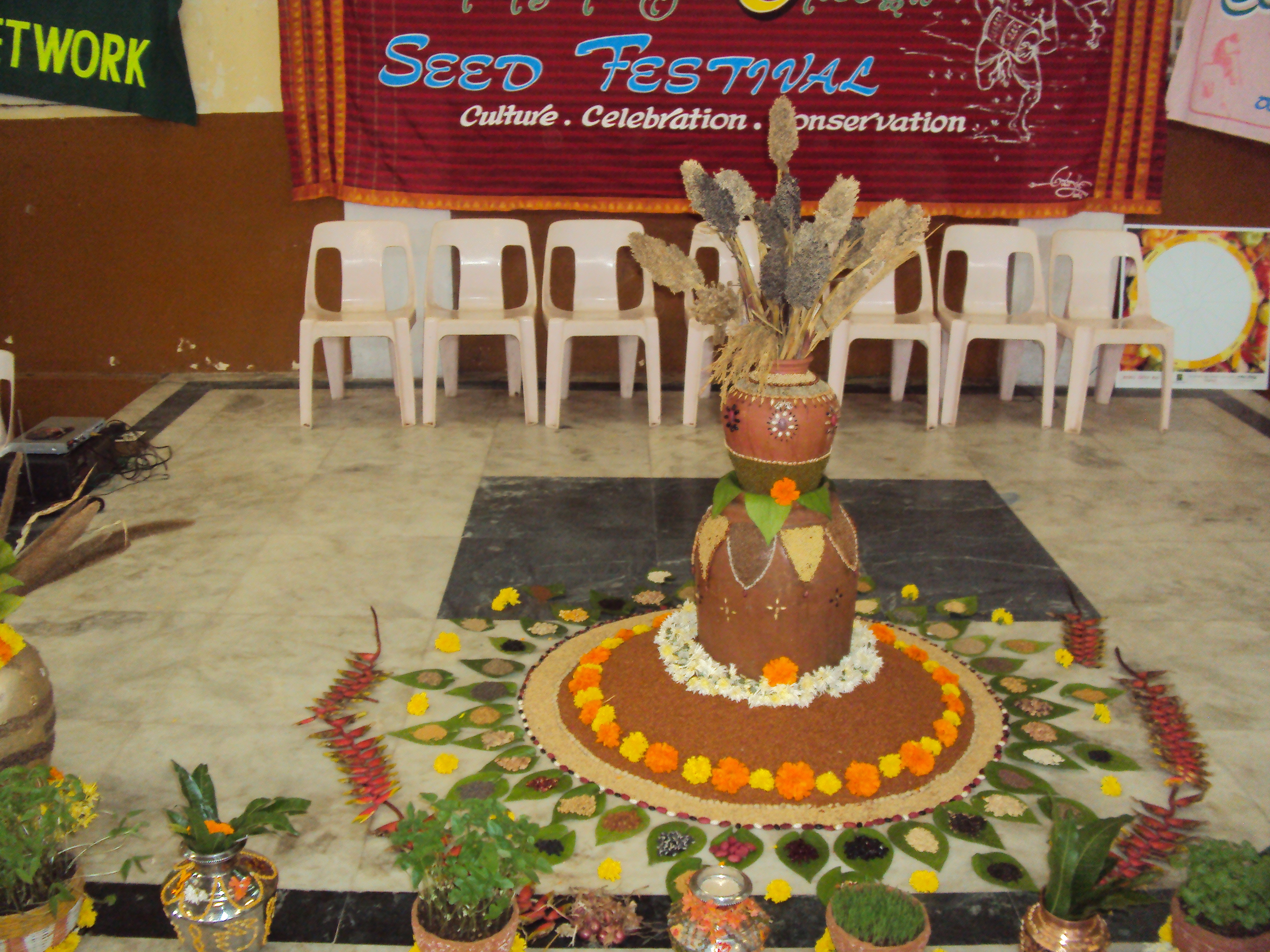By Rev. Thomas John, Companionship Facilitator, Chethana, JH India

Students look over native seeds on display at the Seed Mela (Seed Festival) in Mysore. Photos courtesy of Thomas John.
Agriculture in India is more than 4000 years old. Traditionally, seeds were always considered sacred and imbued with spiritual significance and value – never seen as commodities. Communities were willing to starve to death rather than take the seeds reserved for the next planting season to satisfy their hunger.
To cultivate, preserve and store seeds is the birth right of every farmer and food producer. “Farmers’ rights to save, exchange, evolve, breed, sell seed is at the heart of seed freedom. Seed is not an invention. If we sow one grain of seed, nature multiplies it and gives back 1000 grains. It is the embodiment of bio-cultural diversity and contains millions of years of biological and cultural evolution of the past, and the potential of millennia of a future unfolding.” (Declaration on Seed Freedom: Vandana Siva)
However, in the 1960’s, “seed freedom” began facing serious threats from the influx of the Green Revolution, which represented a shift from traditional crop varieties, seeds and methods of cultivation to the promotion of industry driven seeds, cash crops and technologies, resulting in the destruction of biodiversity, depletion of ground water, and degradation of soils.
Oswald Quintal, of the Kudumbam-LEISA (Low External Input and Sustainable Agriculture) network, argues that the introduction of the Green Revolution led to Multinational Corporations (MNCs) taking control of agriculture in India through the International Rice Research Institute (IRRI) and the International Crop Research Institute for the Semi-Arid Tropics (ICRISAT). The myth propagated was that the world population is growing and we need to produce more food by using high yielding and genetically modified (GM) seeds as well as other modern agricultural practices such as chemical fertilizers and pesticides. If not, there will be acute food shortages.
Five MNCs currently own 68% of all the seeds produced in the world. They also control the fertilizer and pesticide markets as well as the pharmaceutical industry. Mr. Quintal contends further that GM technology is not needed to feed the world’s growing population. Conventional plant breeding has already delivered crops that are high yielding, resistant to disease and pests, resistant to droughts and other extreme climatic conditions, and nutritionally enhanced – all this at a fraction of the cost of GM crops.

The center stage of the festival.
Salome Yesudas, an independent consultant on local food systems and field researcher on the Adivasi/Tribal communities (forest dwellers or First peoples) in Rayagada, stresses the importance of uncultivated foods. Compared to cultivated plant species, wild species of plants are usually more resilient in this age of climate change and serve as a source of safe and free food. People from rural communities of all ages possess an enormous wealth of knowledge about uncultivated foods which could ensure not only food security but also nutritional security.
Chethana, the Joining Hands network in India, held their 14th annual gathering July 4-6, 2014 in Mysore under the theme of “Seed Politics and Kisan Swaraj (Farmers’ Self-rule).” Swaraj is a concept developed by Mahatma Gandhi during India’s struggle for independence. Swaraj literally means self-rule or self-governance, not governance by a hierarchical government, but self-governance by smaller communities in villages. Kisan Swaraj (Farmers’ self-rule) is a clarion call to rural farming communities to rise up and take control of their lives, resources, traditional skills and knowledge, and work for their political and economic emancipation.
Chethana and a few other organizations in Mysore organized a Seed Mela (seed festival), which affirmed the skills and resolve of farmers to protect and popularize native seed varieties. It showcased the immense possibilities for native seeds including: sustainable farming of traditional crops, the value added, commercialization potential and assurance of safe and nutritious food. It was an occasion for celebrating the rich biodiversity existing in the country and to raise awareness amongst the general public.
The Seed Mela and the learning sessions led by activists working on these issues wove the theme of Kisan Swaraj into a beautiful and challenging tapestry that provides hope and direction.
![]() You may freely reuse and distribute this article in its entirety for non-commercial purposes in any medium. Please include author attribution, photography credits, and a link to the original article. This work is licensed under a Creative Commons Attribution-NonCommercial-NoDeratives 4.0 International License.
You may freely reuse and distribute this article in its entirety for non-commercial purposes in any medium. Please include author attribution, photography credits, and a link to the original article. This work is licensed under a Creative Commons Attribution-NonCommercial-NoDeratives 4.0 International License.